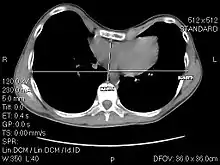Haller index
The Haller index, created in 1987 by J. Alex Haller, S. S. Kramer, and S. A. Lietman,[1] is a mathematical relationship that exists in a human chest section observed with a CT scan. It is defined as the ratio of the transverse diameter (the horizontal distance of the inside of the ribcage) and the anteroposterior diameter (the shortest distance between the vertebrae and sternum).[2]

where:
- HI is the Haller Index
- distance 1 is the distance of the inside ribcage (at the level of maximum deformity or at the lower third of the sternum)
- distance 2 is the distance between the sternal notch and vertebrae.
More recent studies show that simple chest x-rays are just as effective as CT scans for calculating the Haller index and recommend replacing CT scans with CXR to reduce radiation exposure in all but gross deformities.[3][4][5]
A normal Haller index should be about 2.5. Chest wall deformities such as pectus excavatum can cause the sternum to invert, thus increasing the index, which can reach 3.25 or even as high as 5.5[6][7]
See also
Sources
- Haller, JA; Kramer, S. S.; Lietman, S. A. (October 1987). "Use of CT scans in selection of patients for pectus excavatum surgery: a preliminary report". Journal of Pediatric Surgery. 22 (10): 904–6. doi:10.1016/s0022-3468(87)80585-7. PMID 3681619.
- "How the Haller is measured. Departament of Cardiology and Pulmonology of the Hospital das Clínicas da Faculdade de Medicina da Universidade de São Paulo – Thoracic Surgery Sector" (PDF).
- Khanna G (2010). "Comparison of Haller Index values Calculated with chest radiographs versus CT for pectus excavatum evaluation". Pediatr Radiol. 40 (11): 1763–7. doi:10.1007/s00247-010-1681-z. PMID 20473605. S2CID 23984787.
- Poston PM (2015). "The case for using the correction index obtained from chest radiograpghy for evaluation of pectus excavatum". J Pediatr Surg. 50 (11): 1940–4. doi:10.1016/j.jpedsurg.2015.06.017. PMID 26235532.
- Mueller C (2008). "chest x-ray as a primary modality for preoperative imaging of pectus excavatum". J Pediatr Surg. 43 (1): 71–3. doi:10.1016/j.jpedsurg.2007.09.023. PMID 18206458.
- Swoveland, Barbara (2001). "Haller ranges". AORN Journal.
- "Haller Index. Pigeon Chest Problems". 2015. Archived from the original on 2018-03-30. Retrieved 2016-10-19.